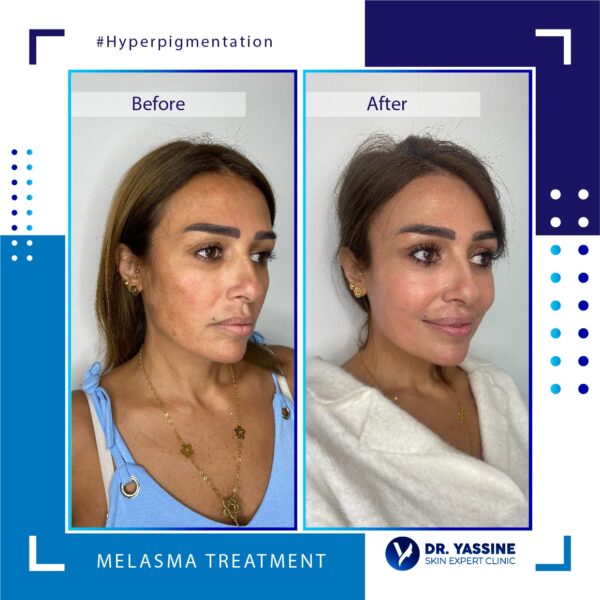Melasma is a well-known skin disorder that affects its pigmentation creating gray-brown spots on facial areas and other body parts exposed to the sun. Dermatologists usually associate the condition with a change of hormones and for this reason, it is common in pregnant women. To benefit from the best melasma treatment, we at Skin Expert Clinic in Beirut, Lebanon, provide our patients with customized skincare protocols, including topical creams, peels, microneedling, and lasers. Dr. Yassine, our top dermatologist, gives you additional information about melasma in the following section.
Melasma

1. What is melasma?
Melasma is the name of a skin problem that causes gray-brown spots on the cheeks, bridge of the nose, forehead, chin, above the upper lip, and sometimes, on parts of the body exposed to the sun, like forearms and neck. To prevent melasma, dermatologists highly recommend sun protection by constantly applying sunscreen and wearing wide-brimmed hats when outside.
This condition is more frequent in women than in men, especially during pregnancy which is why it is sometimes called “the mask of pregnancy”.
2. What causes melasma?
Dermatologists believe the most probable cause of melasma is the overproduction of skin color by the melanocytes, the cells responsible for color-making. That is why it affects people of color more than people with light skin. However, among the things that lead to melasma are sun exposure (which stimulates the melanocytes and brings back melasma once it faded), a change in hormones (that is why birth control pill users and pregnant women are more common victims), and certain skin products that cause skin irritation.
3. How do dermatologists diagnose melasma?
Your dermatologist will most probably diagnose your condition just by looking at your skin. However, to determine the level of melasma’s penetration, your dermatologist may refer to a device named Wood’ light. Since melasma may be confused with another skin condition, your dermatologist may also suggest a skin biopsy, that is, taking a small bit of your skin to rule out other diseases.
4. What is the best way to treat melasma?
Melasma may disappear on its own when certain triggers, like pregnancy and control pills, come to an end. However, it is also common for the condition to exist for years and even a lifetime. In these cases, several treatments will help you out. These include:
- Hydroquinone which can be a cream, lotion, gel, or liquid prescribed by your dermatologist to lighten your skin. At Skin Expert Clinic, Dr. Yassine will prescribe you the option that best suits your skin type, sensitivity, and thickness.
- Tretinoin and corticosteroids: For better lightening, Dr. Yassine may prescribe these medicines as a compliment to hydroquinone, or even one medicine that contains the three components (called triple cream).
- Other topical (applied to the skin) medicines: Azelaic acid, tranexamic acid, or kojic acid are other options Dr. Yassine may prescribe to improve your melasma.
- Procedures: Chemical peels, microdermabrasion, dermabrasion, laser treatment or a light-based procedure are treatments that prove to be more efficient in the case of stubborn melasma.
Outcome
Sometimes, melasma doesn’t fade easily and the improvement takes a few months to be perceived. To avoid side effects and mainly skin irritation, you must follow Dr. Yassine’s advice, who will assure you the perfect result. It is also important not to stop the treatment once your skin clears. Maintenance therapy, which is how Dr. Yassine calls it, with sunscreen SPF 50+ protection (renewed every two hours) will prevent your melasma from coming back.
